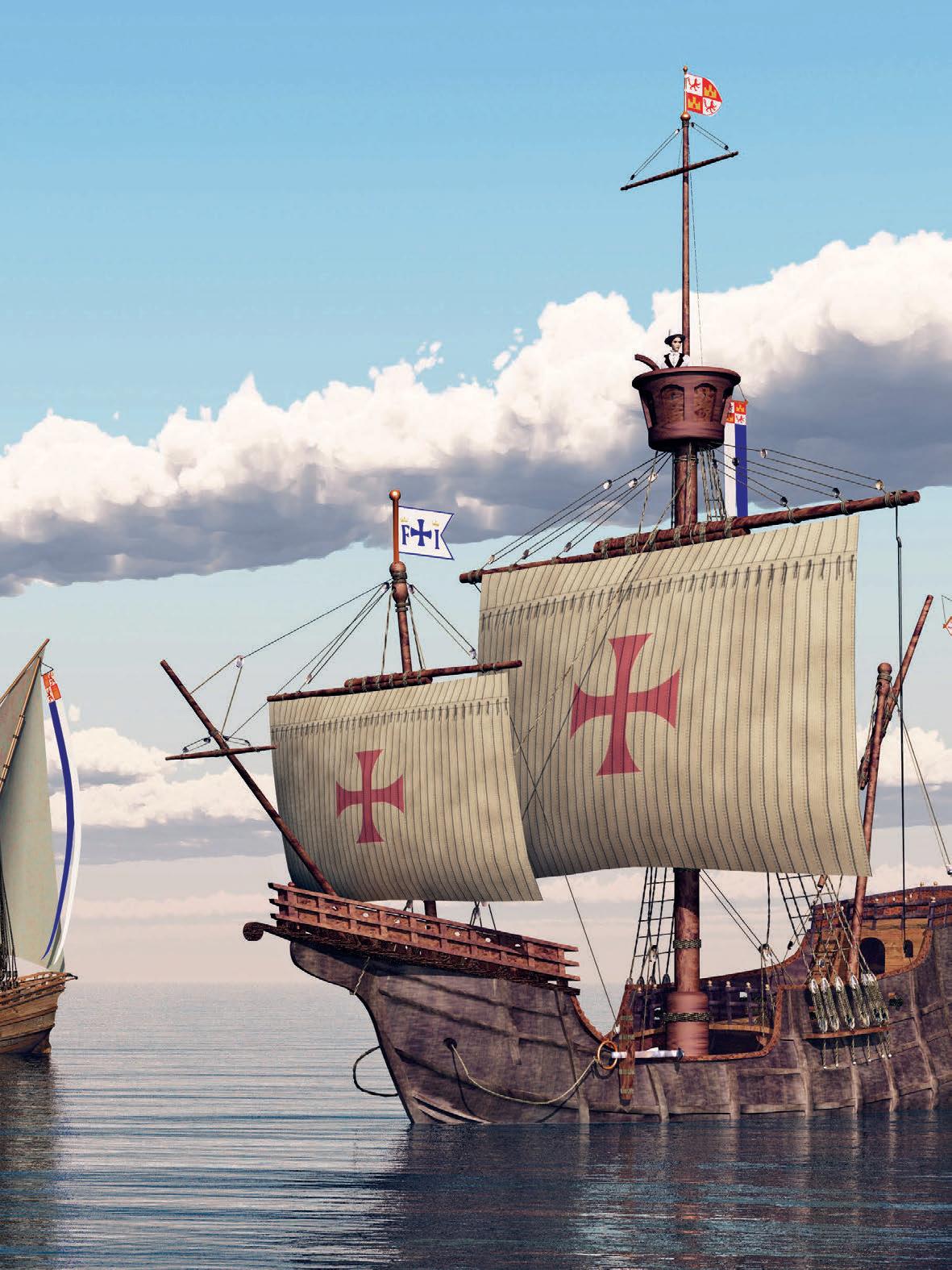
Columbus made four journeys across the Atlantic Ocean between 1492 and 1502. But instead of finding a trade route to India, he landed in the Americas. Thinking it was India, he called the land "the Indies" and the people there "Indians." Sailing from island to island in the Caribbean Sea, he claimed them for the Spanish king and queen.
More than 1,000 years earlier, the Indigenous Taino people had migrated from the northern coast of South America and settled on a number of those Caribbean islands. They lived in small villages, groupe by clans and ruled by a cacique, or male chief. Their society was matrilineal and agricultural. Women made decisions related to families and local Taino village groups. Women also grew crops of pineapples, cassavas, and sweet potatoes, while men hunted and gathered seafood.
Columbus noted in his journal that the Taino "... are the best people in the world, and above all, the gentlest." Assuming they had no religion of their own, Columbus declared that "they would easily be made into Christians." Roman Catholicism was the official religion in Spain, and Spain's rulers hoped to spread their religion to their colonies. Columbus also made a darker observation. With little effort, he thought, "All the inhabitants could be taken away to Spain, or made slaves on the island."
Everywhere Columbus explored, he asked where he might find gold. The Taino people freely gave the bits of gold that they wore to the Spaniards. But it wasn't until Columbus landed on present-day Hispaniola that the Spanish found quantities of the precious metal. That discovery led to the destruction of the Taino people and their way of life throughout the West Indies.
هذه القصة مأخوذة من طبعة March 2023 من Cobblestone American History Magazine for Kids.
ابدأ النسخة التجريبية المجانية من Magzter GOLD لمدة 7 أيام للوصول إلى آلاف القصص المتميزة المنسقة وأكثر من 9,000 مجلة وصحيفة.
بالفعل مشترك ? تسجيل الدخول
هذه القصة مأخوذة من طبعة March 2023 من Cobblestone American History Magazine for Kids.
ابدأ النسخة التجريبية المجانية من Magzter GOLD لمدة 7 أيام للوصول إلى آلاف القصص المتميزة المنسقة وأكثر من 9,000 مجلة وصحيفة.
بالفعل مشترك? تسجيل الدخول

Eye in the Sky
An interview with Joe Piotrowski

Airborne Animals
Humans have taken to the skies in balloons, gliders, and airplanes-but we're not alone among the clouds. Animals of all sorts have evolved to harness wind power.

TAKING OFF
The Wright brothers expected airplanes to “take off,” but even they might be amazed at the way the airline industry has become big business. In the past, it was expensive to send something by plane.

GROWTH OF AN INDUSTRY
After their historic flight at Kitty Hawk in 1903, Wilbur and Orville Wright returned to Dayton, Ohio. They spent the next few years making adjustments and building additional versions of their powered aircraft in their bicycle shop.

WHY KITTY HAWK?
The Wright brothers searched carefully for the best place to test their gliders and flying machines. Their main concern was for good, steady winds. But they also hoped to find a remote location to allow them to perform tests away from the public eye.

Two Brothers From Ohio
Most people do not realize that the Wright brothers—Wilbur, born in 1867, and Orville, born in 1871—performed various scientific experiments before inventing their aircraft. For as long as anyone in their hometown of Dayton, Ohio, could remember, the Wright boys had worked on mechanical projects.

A Helping Hand
May 6, 1896. A group of people who had gathered beside the Potomac River, just south of the U.S. capital, grew quiet. Then, it erupted in cheers as a small, unmanned aircraft took to the skies and flew for more than half a mile. The flight came seven years before the Wright brothers’ first manned, powered flight. The inventor of the aircraft was Dr. Samuel Pierpont Langley.

THE IDEA MEN
People dreamed of flying thousands of years before the Wright brothers found success near Kitty Hawk, North Carolina. These dreamers, such as Leonardo da Vinci, studied birds flying and imagined how humans might do the same—if only they had wings. Other men developed a more hands-on approach to the topic. Early inventors made wings of cloth, glue, and feathers and tied these creations to their arms in an attempt to imitate nature.

Da Vinci's 4 Designs
Have you ever wondered how a bird flies? Leonardo da Vinci (1452–1519) did. He thought that understanding how a bird flies would provide the key to human flight. So, what did da Vinci learn from birds?

Silken Wings
Seven hundred years before the Wright brothers began experimenting with human flight, the Chinese had already mastered its secrets—with kites.